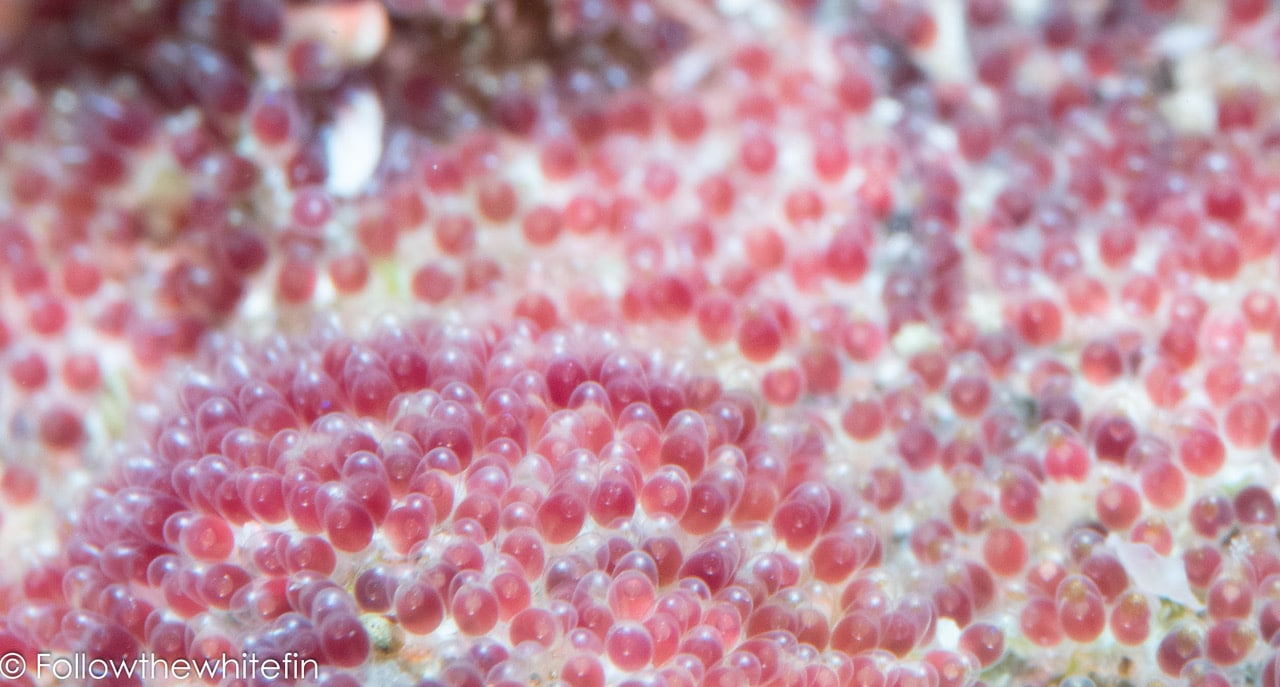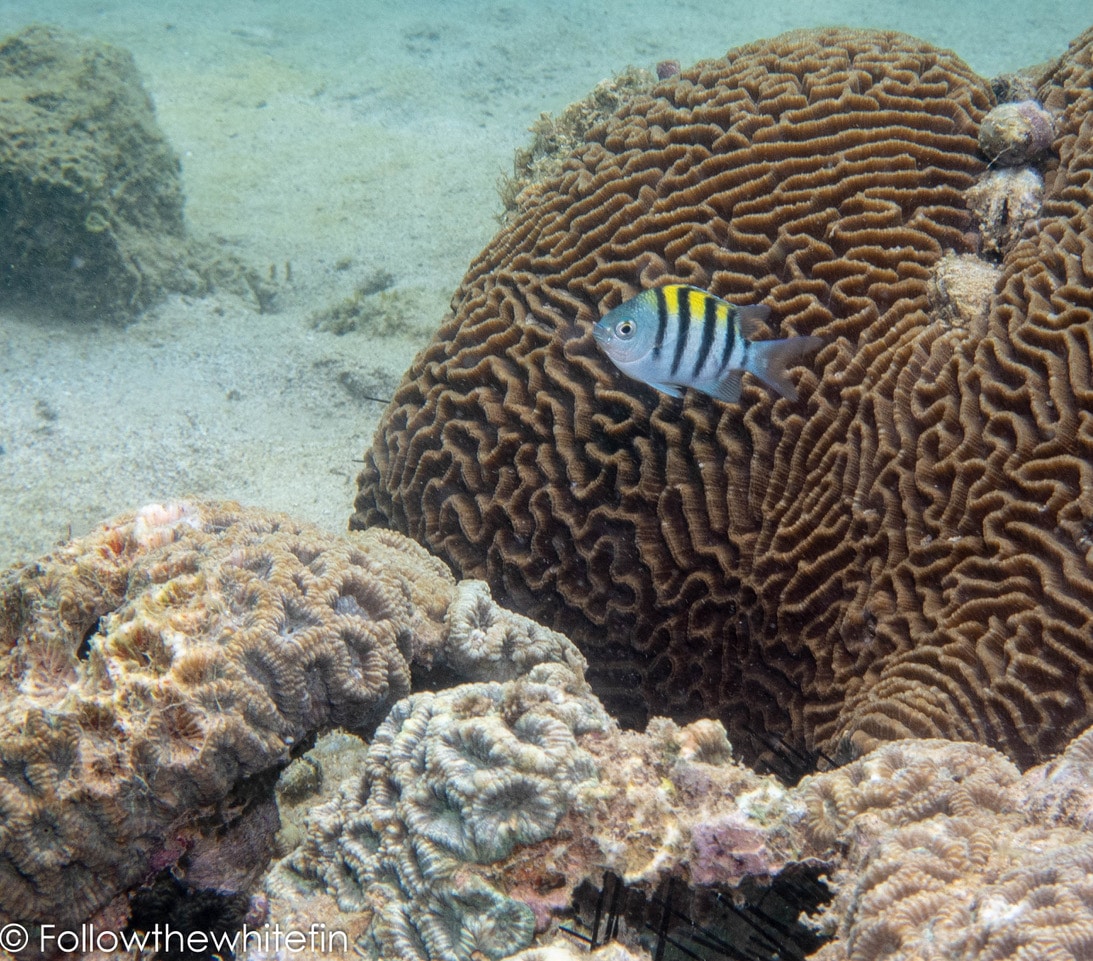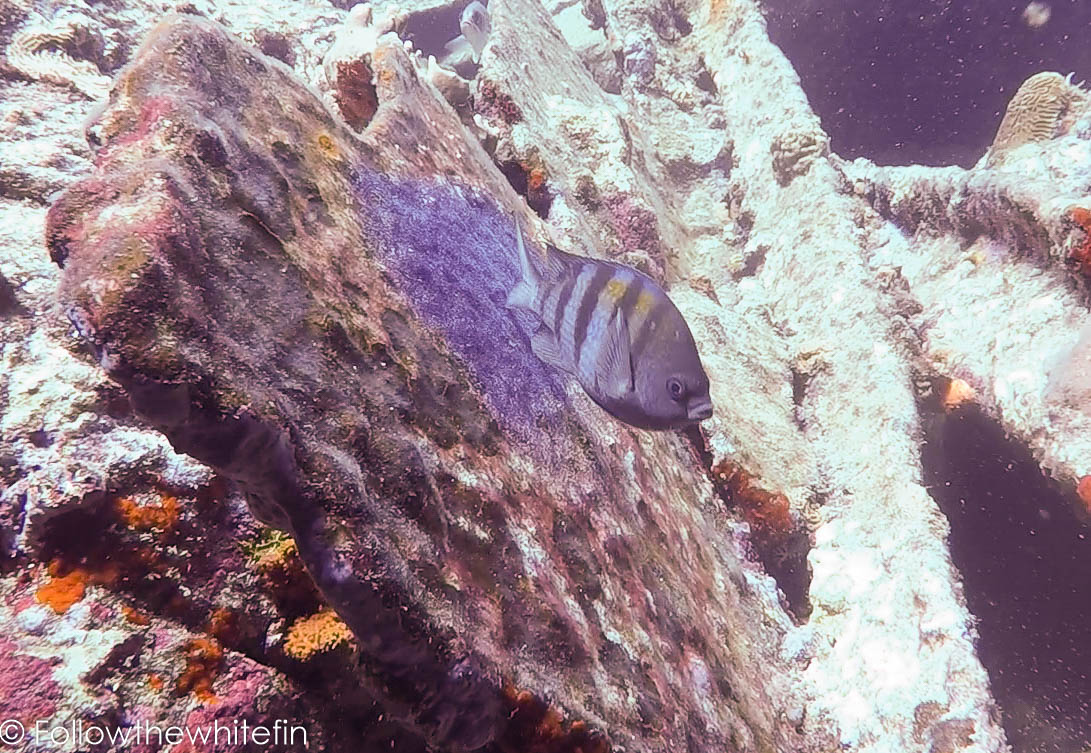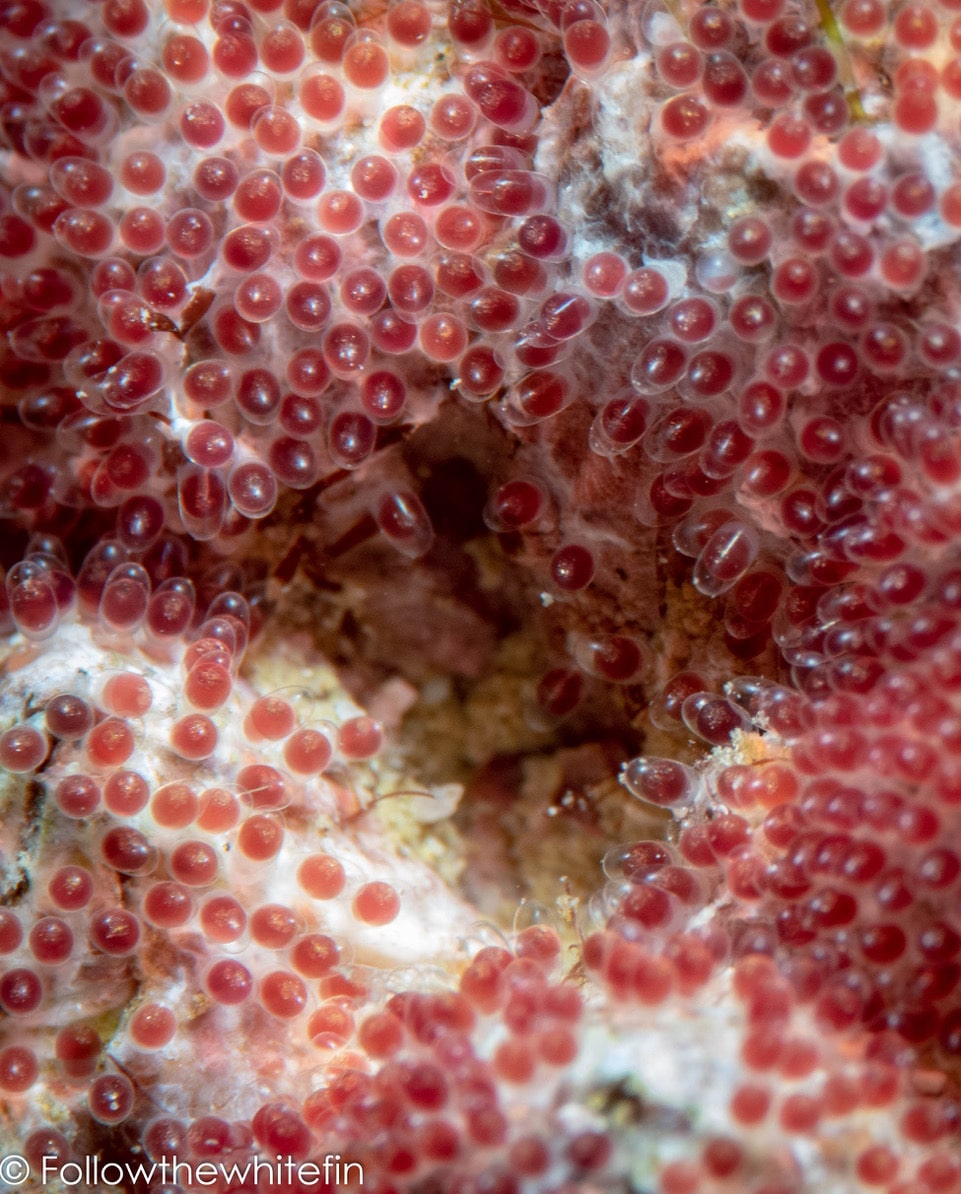Marine Life & Conservation Blogs
The Sergeant Major Fish: Underdog to Super-Dad

You’re on a dive, minding your own business when suddenly, your mask is being bombarded by a frantic and extremely angry creature. In shock you reverse, exiting the firing line when you realise that the monster in question is none other than the Sergeant Major Fish.
If your biggest fear in the ocean is the ‘dreaded shark’, think again, it’s the Sergeant Major you really have to worry about!! In disbelief you take a second glance and notice that the creatures you once thought were small and peaceful are all behaving in this manner to anything crossing or invading their path.
Why do they behave like this? And why have you never noticed this before?
Background Check
Abudefduf is from the Arabic; abu “the one with”, def “side”, and duf “prominent”. Its name, referring to the vertical black bars on its side, roughly translating to “the one with prominent sides”. This is also where its gets its common name “Sergeant Major,” as the stripes resemble the bars on a military uniform. Despite the general common name Sergeant Major there are up to 20 species of this damselfish, part of the family Pomacentridae, that you can be found worldwide. Generally, their bodies are deep, oval and compressed with a continuous dorsal fin and a forked caudal fin, but each species varies in size and the number of dorsal fins, dorsal soft rays, anal spines and anal soft rays.
Meet the Locals
Here in the UAE we have the Indo-pacific Sergeant Abudefduf vaigiensis. Widely distributed throughout the Indo-Pacific: Red Sea, Indian Ocean to eastern Africa, north to southern Japan, and south to Australia. In 1991, it was even discovered in the Hawaiian Islands, possibly floating marine debris such as abandoned fishing nets, where it now coexists with the Hawaiian Sergeant Abudefduf abdominalis. They form large aggregations while feeding during the day and play hide and seek by themselves at night on coral reefs, tidal pools and rocky reefs at depths between 1 to 15 m. The Indo-pacific Sergeant can grow up to 20 centimetres long, feeding on zooplankton, benthic algae and small invertebrates.
The Interesting Part!
So now you have the Sergeant Major’s background check. Here’s the fascinating part!
Between March and August, the Sergeant Majors congregate in large numbers to reproduce. To start the process, the males prepare temporary nesting sites by coating patches of rocks, shipwrecks and corals with an adhesive substrate. The females then wander around looking for that special partner to mate with. When a female is near, the male will try to attract the female by preforming a unique and intriguing dance which involves moving up and down erratically, like the local dance club. If she’s digging his moves she will deposit up to 20,000 eggs. Once the eggs have dispersed, they attach themselves to the substrate the males prepared and will then be fertilized.
After all the fun, the females eventually take off leaving the males with all the responsibility of protecting his little patch. The male is extremely attentive by continuously aerating his eggs stopping fungus build up. He will also turn a darker bluish colour which most likely acts as a warning colour to predators or even possible camouflage. Any fish that comes too close are aggressively chased away and divers are left in bewilderment.
The eggs start as solid red ovals around 0.5-0.9mm. Once they are fertilised they start to turn a green colour with a deep red yolk leaving the surfaces as a patchwork. After 4-5 days the eggs will hatch an hour after sunset. If you are able to see the hatching, it can be amazing to watching as they wiggle out from the substrate and break free. Once hatched they are around 2.4mm in size and set off to tackle the big blue ocean.
I have been very privileged over the last few weeks to witness parts of this process and they are amazing to watch. The reef has literally been covered in patches of varying shades of red and green. The determination of the male Sergeant Major whilst hilarious to watch is also impressing for such a small creature to display. With my new camera I was able to catch some of these processes, but my next goal is to capture the courtship ritual and hatching (I may need a bigger camera though).
Next time you are out diving, make sure you don’t overlook the little guys, and look out for the patchwork of the ocean created by the Sergeant Major Fish.
Find out more about Kayleigh at www.followthewhitefin.com
Blogs
Saba’s Plan for a Coral Comeback

Saba has an exciting new initiative to restore its coral reefs. This new project, running from 2024 to 2026, will focus on reviving key species in the island’s underwater ecosystems. With a collaborative team from the Saba Conservation Foundation (SCF) and Van Hall Larenstein (VHL) University of Applied Sciences, the project aims to restore both corals as well as sea urchins.
This initiative is centered around coral restoration, specifically reviving two essential coral species—staghorn coral (Acropora cervicornis) and elkhorn coral (Acropora palmata). By mapping parent colonies and using a technique known as coral gardening, SCF will create and maintain coral nurseries. These corals will eventually be outplanted at key reef sites around Saba to not only expand the number of coral colonies, but also provide essential fish habitat. The project focusses on installing coral nurseries, training staff with the newest techniques and starting with the restoration of key reef sites.

Reef Cleaners to the Rescue
It’s not just corals getting a makeover—this project also shines a spotlight on the essential role of grazers, particularly sea urchins. VHL is leading the charge on cultivating and restocking two key sea urchin species, West Indian sea egg (Tripneustes) and long-spined sea urchin (Diadema), known for their ability to keep algae in check. By removing algae, which are important competitors of corals, they help the coral to thrive. By restoring these “reef cleaners,” Saba’s project will give corals the breathing room they need to grow, setting the stage for a healthier, more balanced marine ecosystem.
From Tiny Urchins to Big Goals
The project will be funded as part of the Dutch Government’s Nature and Environment Policy Plan (NEPP) 2020-2030 for the Caribbean Netherlands, a comprehensive initiative aimed at conserving and restoring the unique natural environments of the Dutch Caribbean islands, including Saba, St. Eustatius, and Bonaire. This project is aiming for big milestones: build and maintaining coral nurseries, the expansion of urchin cultivation facilities, and the creation of a dedicated research center. By 2026, the project hopes to ramp up coral and grazer restoration, with the ultimate goal of extending these efforts across the Dutch Caribbean. By linking local initiatives to broader regional goals, Saba’s restoration project promises to leave a lasting impact on both the environment and the community.
Find out more about the DCNA at dcnanature.org.
Blogs
Reef-World marks two decades of marine conservation: strengthening impact amid coral reef threats

Empowering ocean stakeholders to tackle future challenges and ensure the survival of coral reefs and humanity
2024 marks the 20th Anniversary of The Reef-World Foundation’s tireless efforts for global coral reef conservation. The UK charity is the international coordinator of the UN Environment Programme’s Green Fins initiative, known as the leading voice in sustainable marine tourism. Today, Reef-World released its 2023-2024 Impact Report outlining a year of substantive growth and impact in its marine conservation programmes.

Impact Report Highlights:
- Impressive improvements in environmental behaviours to protect coral reefs by the marine tourism industry as the global participation of Green Fins increases.
- Continued capacity building for government and NGO staff to effectively manage marine tourism activities in Asia, Caribbean and Red Sea regions.
- For the first time in Green Fins’ 20-year history, tourism operators have achieved ‘Best Environmental Performer’ status by demonstrating the lowest possible environmental impact in their environmental assessments. In 2024, three dive operators achieved this challenging milestone.
- Significant increases in global participation of Reef-World’s innovative digital conservation tools.
- 138 Green Fins dive operator members achieved the strict threshold for PADI Eco Center recognition.
- Developed four new educational materials and translated two into 16 languages to support the marine tourism industry in achieving sustainability targets.
- Establishing a new Reef-World Development strategy and recruiting new roles – Development and Programmes Managers.
- Reef-World’s board welcomes new Chair and Trustees strengthening organisational leadership.

Reef-World started as a one-person mission to inspire and empower communities to act in conserving and sustainably developing coral reefs and related ecosystems. Today, the team of 12 continues to meet this mission by inspiring and empowering the global marine tourism community to be exemplary sustainability leaders by using the Green Fins guidelines and tools to simultaneously use and protect the world’s precious reefs.
In April 2024, the fourth global coral reef bleaching event was confirmed. Reef-World’s work has never been more urgent as the marine environment, and the benefits they provide humanity, continue to be eroded by global threats. The reduction of local threats, like those from the marine tourism industry, is an essential step to ensuring a future where coral reefs survive and continue to support the millions of people who depend on their ecosystem benefits. Reef-World’s work buys time for coral reefs and related ecosystems to be resilient to the impacts of global threats.
“Right now our corals are facing the greatest fight of their existence as the terrifying predictions of the steps towards their complete extinction are starting to come true. But all is not lost, reefs are resilient and they have existed on this planet for millions of years. We must take action now, to buy time for reefs by reducing threats facing them and allowing them to react and adjust to the changing environment they need to survive in.” – Chloe Harvey, Executive Director
Looking Forwards:
Like coral reefs, the Reef-World team needs to be resilient in the face of the complex challenges of the conservation sector. Reef-World has invested significantly in developing a Culture of Care to ensure the well-being of its team on a daily basis, continuing to be an exemplary employer to enable its team to best achieve the mission for coral reef conservation.
With the foundations of a Culture of Care and organisational development laid, Reef-World is emerging from the end of a natural organisation life cycle, that brings the challenges of growth and scale, stronger than ever. With a new strategy in place to generate much needed resources, Reef-World is excited for the opportunities to leap forward, continue to scale our impact and lean into new innovations and untapped opportunities for marine conservation.
We continually strive to become a forward-thinking organisation that delivers on our goals and commitments to our stakeholders with fresh approaches and not being afraid of steering away from a “normal approach.” This approach is not only applied to our programmes of work but also internally and carries over to our Culture of Care for our team.” — JJ Harvey, Operations Director

The Reef-World Foundation is immensely grateful for the continued support of its grant funders: UN Environment Programme, IUCN’s Blue Natural Capital Financing Facility, Adventure Travel Conservation Fund, PADI Aware Foundation, and World Nomads Footprints Program.
Reef-World would also like to express its gratitude to international partners whose vital support has resulted in significant tangible benefits for our work and mission: PADI; Professional SCUBA Schools International (PSS); Explorer Ventures; 1% for the Planet; ZuBlu; Snorkel Venture, GSTC; Dive O’Clock; Seven Dragons; DiveAssure and Eco Beach, without whom these achievements would not be possible.
The full 2023–2024 Annual Impact Report is available on Reef-World’s website.
-

 News1 month ago
News1 month agoIconic SS United States to become the World’s Largest Artificial Reef
-

 Blogs3 months ago
Blogs3 months agoNovoScuba’s Game-Changing Approach for Dive Store Owners: WE PAY YOU!
-

 News2 months ago
News2 months agoBook Review – 52 Assignments: Underwater Photography
-

 Gear News2 months ago
Gear News2 months agoDYNAMICNORD – New German diving brand enters the British market
-

 News2 months ago
News2 months agoExploring Cenote El Pit: A Diver’s Dream
-

 Gear News2 months ago
Gear News2 months agoTry BARE drysuits (and maybe even win one!) this Friday with Sea & Sea at North West Dive Fest
-

 News3 months ago
News3 months agoComing Soon – 52 Assignments
-

 News3 months ago
News3 months agoSave £200 per person per week at Pole Pole Lodge with Dive Worldwide
















